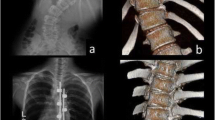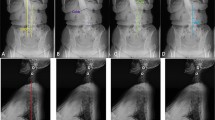Abstract
Introduction
An accurate assessment of three-dimensional (3D) intervertebral deviation is crucial to the better surgical correction of adolescent idiopathic scoliosis (AIS). However, a precise 3D study of intervertebral deviation has not been previously reported.
Objective
The purpose of the present study is to evaluate the intervertebral coronal inclination, axial rotation and sagittal angulation of AIS using 3D bone models and a local coordinate system.
Materials and methods
3D bone models of the thoracic and lumbar spine of ten AIS patients were constructed using computed tomography. The local coordinate axis was determined semi-automatically for each vertebra. By using these local coordinates, the intervertebral deviation angles were calculated in the coronal, axial and sagittal planes and projected to subjacent local coordinates.
Result
The intervertebral deformity in the coronal plane was larger near the apical region and smaller near the junctional region. Conversely, the intervertebral rotation in the axial plane was smaller near the apical region, and larger near the junctional region. Concerning the sagittal plane deformity, the constant tendency was not recognized.
Conclusion
Using a local coordinate system for the vertebra of AIS, we measured the 3D intervertebral coronal, axial and sagittal deviation of the thoracolumbar spine and found that the change in the intervertebral inclination angle in the coronal plane increased toward the apical region and decreased toward the junctional region, and that the converse tendency was noted for the axial intervertebral rotational angle. This analysis provides an improved 3D guide for the surgical correction of AIS.




Similar content being viewed by others
References
Asghar J, Samdani AF, Pahys JM, D’andrea LP, Guille JT, Clements DH, Betz RR (2009) Computed tomography evaluation of rotation correction in adolescent idiopathic scoliosis: a comparison of an all pedicle screw construct versus a hook-rod system. Spine 34:804–807
Benameur S, Mignotte M, Parent S, Labelle H, Skalli W, Guise J (2002) 3D biplanar statistical reconstruction of scoliotic vertebrae. Stud Health Technol Inform 91:281–285
Carpineta L, Labelle H (2003) Evidence of three-dimensional variability in scoliotic curves. Clin Orthop Relat Res 412:139–148
Cruickshank JL, Koike M, Dickson RA (1989) Curve patterns in idiopathic scoliosis. A clinical and radiographic study. J Bone Joint Surg [Br] 71:259–263
Dubousset J (1994) Three-dimensional analysis of the scoliotic deformity. In: Weinstein SL (ed) The pediatric Spine: Principles and Practices. Raven Press, New York, pp 479–496
Dumas R, Mitton D, Laporte S, Dubousset J, Steib JP, Lavaste F, Skalli W (2003) Explicit calibration method and specific device designed for stereoradiography. J Biomech 36:827–834
Dumas R, Steib JP, Mitton D, Lavaste F, Skalli W (2003) Three-dimensional quantitative segmental analysis of scoliosis corrected by the in situ contouring technique. Spine 28:1158–1162
Kadoury S, Cheriet F, Laporte C, Labelle H (2007) A versatile 3D reconstruction system of the spine and pelvis for clinical assessment of spinal deformities. Med Bio Eng Comput 45:591–602
Kadoury S, Cheriet F, Beauséjour M, Stokes IA, Parent S, Labelle H (2009) A three-dimensional retrospective analysis of the evolution of spinal instrumentation for the correction of adolescent idiopathic scoliosis. Eur Spine J 18:23–37
Kotwicki T, Napiontek M (2008) Intravertebral deformation in idiopathic scoliosis a transverse plane computer tomographic study. J Pediatr Orthop 28:225–229
King HA, Moe JH, Bradford DS, Winter RB (1983) The selection of fusion levels in thoracic idiopathic scoliosis. J Bone Joint Surg Am 65:1302–1313
Labelle H, Dansereau J, Blellefleur C, de Guise J, Rivard CH, Poitras B (1995) Peroperative three-dimensional correction of idiopathic scoliosis with the Cotrel–Dubousset procedure. Spine 15:1406–1409
Lenke LG, Bridwell KH, Baldus C, Blanke K, Schoenecker PL (1992) Cotrel–Dubousset instrumentation for adolescent idiopathic scoliosis. J Bone Joint Surg Am 74:1056–1067
Lenke LG, Bridwell KH, O’Brien MF, Baldus C, Blanke K (1994) Recognition and treatment of the proximal thoracic curve in adolescent idiopathic scoliosis with Cotrel–Dubousset instrumentation. Spine 15:1589–1597
Little DG, Sussman MD (1994) The Risser sign: a critical analysis. J Pediatr Orthop 14:569–575
Mitton D, Landry C, Véron S, Skalli W, Lavaste F, Guise JA (2000) 3D reconstruction method from biplanar radiography using non-stereocorresponding points and elastic deformable meshes. Med Biol Eng Comp 38:133–139
Moens P, Vanden Berqhe L, Fabry G, Bellemans J (1995) The Cortel–Dubousset device: prospective study on derotation. Rev Chir Orthop Reparatrice Appar Mot 81:428–432
Modi HN, Suh SW, Song HR, Lee SH, Yang JH (2008) Differential wedging vertebral body and intervertebral disc in thoracic and lumbar spine in adolescent idiopathic scoliosis—a cross sectional study in 150 patients. Scoliosis 3:11
Nash CL, Moe JH (1969) A study of vertebral rotation. J Bone Joint Surg Am 54:223–229
Oka K, Moritomo H, Murase T, Goto A, Sugamoto K, Yoshikawa H (2005) Patterns of carpal deformity in scaphoid nonunion: a 3-dimensional and quantitative analysis. J Hand Surg [Am] 30:1136–1144
Parent S, Labelle H, Skalli W, Latimer B, Guise J (2002) Morphometric analysis of anatomic scoliotic specimens. Spine 27:2305–2311
Parent S, Labelle H, Skalli W, Guise J (2004) Thoracic pedicle morphometry in vertebrae from scoliotic spines. Spine 29:239–248
Parent S, Labelle H, Skalli W, Guise J (2004) Vertebral wedging characteristic changes in scoliotic spines. Spine 29:E455–E462
Perdriolle R (1979) La scoliose: Son e′tude Tridimensionnelle. Ed. Maloine, Paris
Perdriolle R, Vidal J (1987) Morphology of scoliosis three-dimensional evolution. Orthopedics 10:909–915
Sawatzky BJ, Tredwell SJ, Jang SB, Black AH (1998) Effects of three-dimensional assessment on surgical correction and on hook strategies in multi-hook instrumentation for adolescent idiopathic scoliosis. Spine 23:201–205
Steib JP, Dumas R, Mitton D, Skalli W (2004) Surgical correction of scoliosis by in situ contouring: a detorsion analysis. Spine 29:193–199
Torell G, Nachemson A, Haderspeck-Grib K, Schultz A (1985) Standing and supine Cobb measures in girls with idiopathic scoliosis. Spine 10:425–427
Yazici M, Acaroglu ER, Alanay A, Deviren V, Cila A, Surat A (2001) Measurement of vertebral rotation in standing versus supine position in adolescent idiopathic scoliosis. J Pediatr Orthop 21:252–256
Conflict of interest
None.
Author information
Authors and Affiliations
Corresponding author
Rights and permissions
About this article
Cite this article
Hattori, T., Sakaura, H., Iwasaki, M. et al. In vivo three-dimensional segmental analysis of adolescent idiopathic scoliosis. Eur Spine J 20, 1745–1750 (2011). https://doi.org/10.1007/s00586-011-1869-4
Received:
Revised:
Accepted:
Published:
Issue Date:
DOI: https://doi.org/10.1007/s00586-011-1869-4




